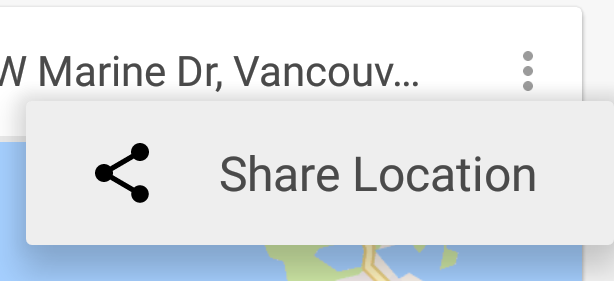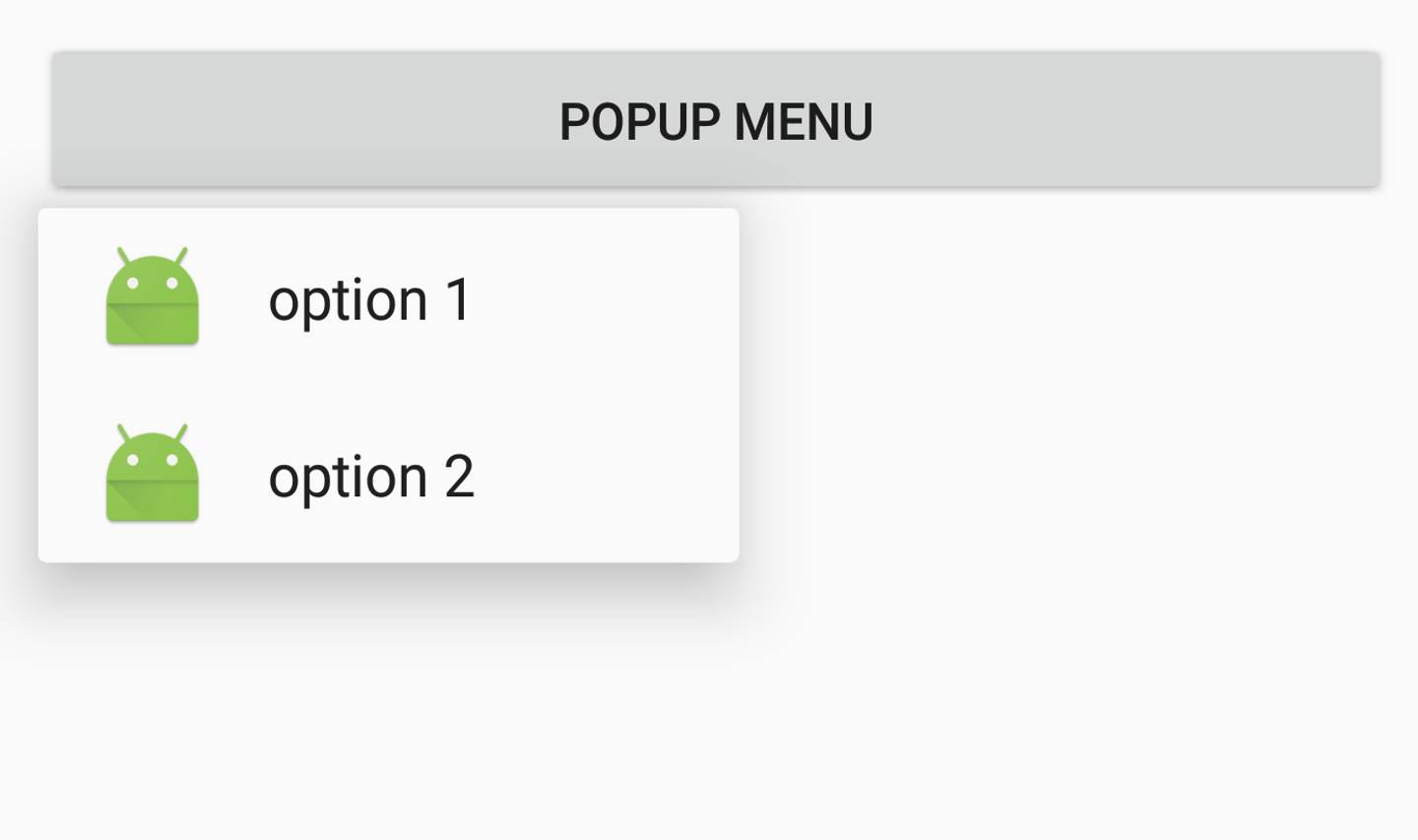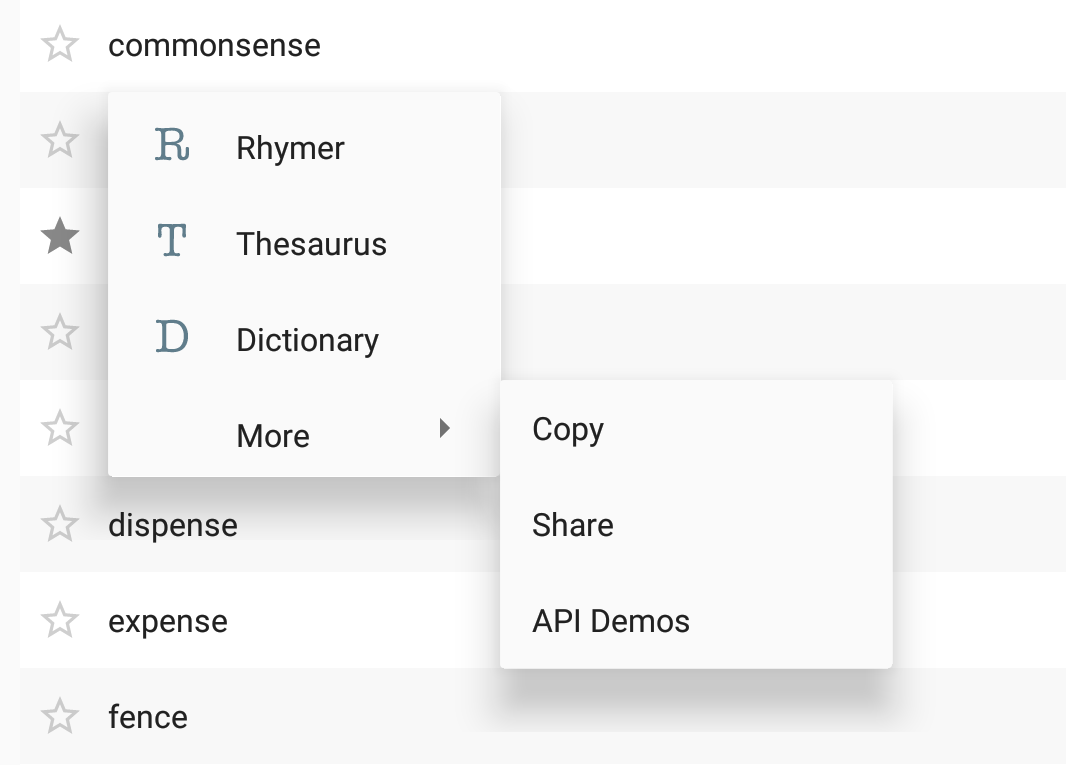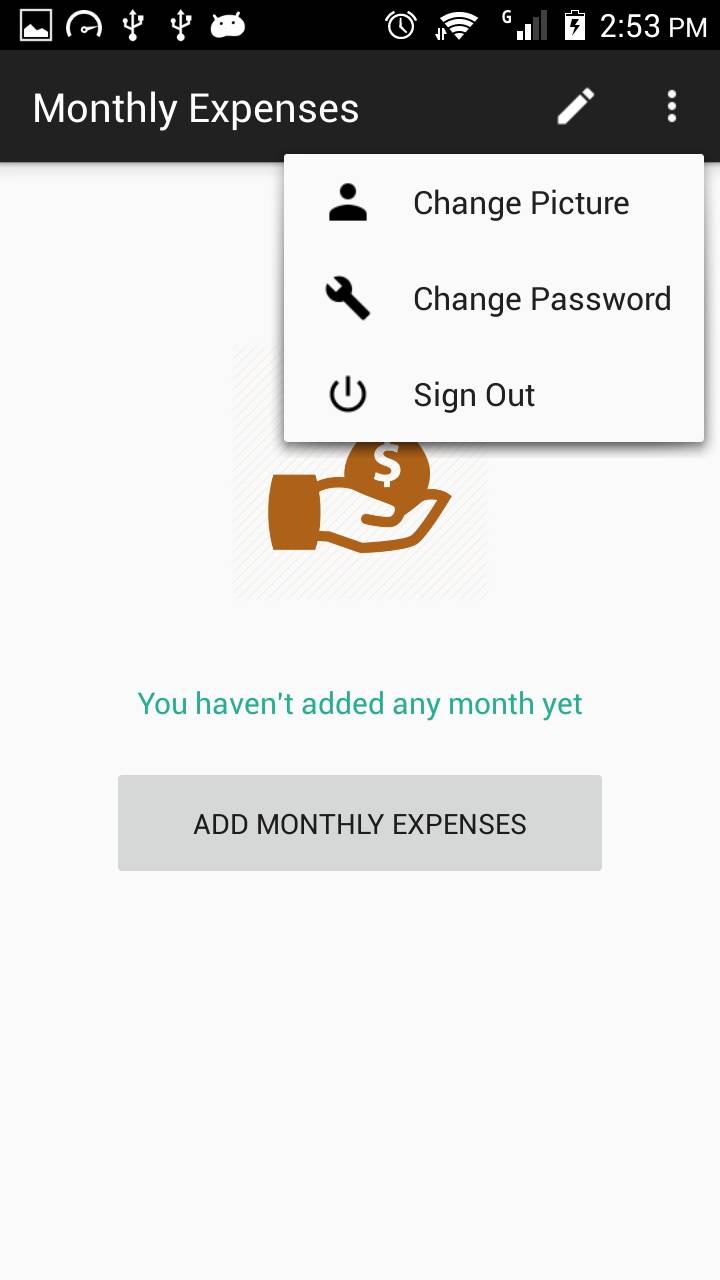PopupMenu avec des icônes [dupliquer]
cette question a déjà une réponse ici:
bien sûr, il s'agit ici de SDK 11 et au-dessus.
j'ai l'intention de faire quelque chose de similaire à ceci:
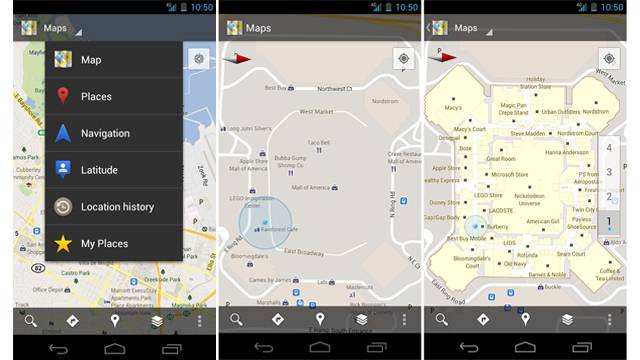
à côté de chaque article dans ce PopupMenu , je voudrais placer une icône .
j'ai créé un fichier XML et l'ai placé dans /menu :
<menu xmlns:android="http://schemas.android.com/apk/res/android" >
<item
android:id="@+id/action_one"
android:title="Sync"
android:icon="@android:drawable/ic_popup_sync"
/>
<item
android:id="@+id/action_two"
android:title="About"
android:icon="@android:drawable/ic_dialog_info"
/>
</menu>
comme vous l'avez remarqué, dans le fichier xml Je définit les icônes que je veux, cependant, quand le menu popup s'affiche, il les affiche sans les icônes. Que dois-je faire pour que ces 2 icônes apparaissent?
12 réponses
je voudrais mettre en œuvre autrement:
créer un PopUpWindow mise en page:
<?xml version="1.0" encoding="utf-8"?>
<LinearLayout xmlns:android="http://schemas.android.com/apk/res/android"
android:id="@+id/llSortChangePopup"
android:layout_width="wrap_content"
android:layout_height="wrap_content"
android:background="@drawable/sort_popup_background"
android:orientation="vertical" >
<TextView
android:id="@+id/tvDistance"
android:layout_width="match_parent"
android:layout_height="wrap_content"
android:text="@string/distance"
android:layout_weight="1.0"
android:layout_marginLeft="20dp"
android:paddingTop="5dp"
android:gravity="center_vertical"
android:textColor="@color/my_darker_gray" />
<ImageView
android:layout_marginLeft="11dp"
android:layout_width="wrap_content"
android:layout_height="wrap_content"
android:src="@drawable/sort_popup_devider"
android:contentDescription="@drawable/sort_popup_devider"/>
<TextView
android:id="@+id/tvPriority"
android:layout_width="match_parent"
android:layout_height="wrap_content"
android:text="@string/priority"
android:layout_weight="1.0"
android:layout_marginLeft="20dp"
android:gravity="center_vertical"
android:clickable="true"
android:onClick="popupSortOnClick"
android:textColor="@color/my_black" />
<ImageView
android:layout_marginLeft="11dp"
android:layout_width="wrap_content"
android:layout_height="wrap_content"
android:src="@drawable/sort_popup_devider"
android:contentDescription="@drawable/sort_popup_devider"/>
<TextView
android:id="@+id/tvTime"
android:layout_width="match_parent"
android:layout_height="wrap_content"
android:text="@string/time"
android:layout_weight="1.0"
android:layout_marginLeft="20dp"
android:gravity="center_vertical"
android:clickable="true"
android:onClick="popupSortOnClick"
android:textColor="@color/my_black" />
<ImageView
android:layout_marginLeft="11dp"
android:layout_width="wrap_content"
android:layout_height="wrap_content"
android:src="@drawable/sort_popup_devider"
android:contentDescription="@drawable/sort_popup_devider"/>
<TextView
android:id="@+id/tvStatus"
android:layout_width="match_parent"
android:layout_height="wrap_content"
android:text="@string/status"
android:layout_weight="1.0"
android:layout_marginLeft="20dp"
android:gravity="center_vertical"
android:textColor="@color/my_black"
android:clickable="true"
android:onClick="popupSortOnClick"
android:paddingBottom="10dp"/>
</LinearLayout>
et ensuite créer le PopUpWindow dans votre Activity :
// The method that displays the popup.
private void showStatusPopup(final Activity context, Point p) {
// Inflate the popup_layout.xml
LinearLayout viewGroup = (LinearLayout) context.findViewById(R.id.llStatusChangePopup);
LayoutInflater layoutInflater = (LayoutInflater) context.getSystemService(Context.LAYOUT_INFLATER_SERVICE);
View layout = layoutInflater.inflate(R.layout.status_popup_layout, null);
// Creating the PopupWindow
changeStatusPopUp = new PopupWindow(context);
changeStatusPopUp.setContentView(layout);
changeStatusPopUp.setWidth(LinearLayout.LayoutParams.WRAP_CONTENT);
changeStatusPopUp.setHeight(LinearLayout.LayoutParams.WRAP_CONTENT);
changeStatusPopUp.setFocusable(true);
// Some offset to align the popup a bit to the left, and a bit down, relative to button's position.
int OFFSET_X = -20;
int OFFSET_Y = 50;
//Clear the default translucent background
changeStatusPopUp.setBackgroundDrawable(new BitmapDrawable());
// Displaying the popup at the specified location, + offsets.
changeStatusPopUp.showAtLocation(layout, Gravity.NO_GRAVITY, p.x + OFFSET_X, p.y + OFFSET_Y);
}
enfin pop it up onClick d'un bouton ou n'importe quoi d'autre:
imTaskStatusButton.setOnClickListener(new OnClickListener()
{
public void onClick(View v)
{
int[] location = new int[2];
currentRowId = position;
currentRow = v;
// Get the x, y location and store it in the location[] array
// location[0] = x, location[1] = y.
v.getLocationOnScreen(location);
//Initialize the Point with x, and y positions
point = new Point();
point.x = location[0];
point.y = location[1];
showStatusPopup(TasksListActivity.this, point);
}
});
bon exemple pour PopUpWindow :
http://androidresearch.wordpress.com/2012/05/06/how-to-create-popups-in-android /
cela fonctionne si vous utilisez AppCompat v7. C'est un peu hacky mais de manière significative mieux que d'utiliser la réflexion et vous permet toujours d'utiliser le noyau Android PopupMenu:
PopupMenu menu = new PopupMenu(getContext(), overflowImageView);
menu.inflate(R.menu.popup);
menu.setOnMenuItemClickListener(new PopupMenu.OnMenuItemClickListener() { ... });
MenuPopupHelper menuHelper = new MenuPopupHelper(getContext(), (MenuBuilder) menu.getMenu(), overflowImageView);
menuHelper.setForceShowIcon(true);
menuHelper.show();
res/menu/popup.xml
<?xml version="1.0" encoding="utf-8"?>
<menu xmlns:android="http://schemas.android.com/apk/res/android">
<item android:id="@+id/menu_share_location"
android:title="@string/share_location"
android:icon="@drawable/ic_share_black_24dp"/>
</menu>
Il en résulte dans le menu contextuel en utilisant l'icône qui est définie dans votre menu fichier de ressources:
menu popup Android a une méthode cachée pour afficher l'icône de menu. Utilisez Java reflection pour l'activer comme ci-dessous code snippet.
public static void setForceShowIcon(PopupMenu popupMenu) {
try {
Field[] fields = popupMenu.getClass().getDeclaredFields();
for (Field field : fields) {
if ("mPopup".equals(field.getName())) {
field.setAccessible(true);
Object menuPopupHelper = field.get(popupMenu);
Class<?> classPopupHelper = Class.forName(menuPopupHelper
.getClass().getName());
Method setForceIcons = classPopupHelper.getMethod(
"setForceShowIcon", boolean.class);
setForceIcons.invoke(menuPopupHelper, true);
break;
}
}
} catch (Throwable e) {
e.printStackTrace();
}
}
menu contextuel avec icône en utilisant MenuBuilder et MenuPopupHelper
MenuBuilder menuBuilder =new MenuBuilder(this);
MenuInflater inflater = new MenuInflater(this);
inflater.inflate(R.menu.menu, menuBuilder);
MenuPopupHelper optionsMenu = new MenuPopupHelper(this, menuBuilder, view);
optionsMenu.setForceShowIcon(true);
// Set Item Click Listener
menuBuilder.setCallback(new MenuBuilder.Callback() {
@Override
public boolean onMenuItemSelected(MenuBuilder menu, MenuItem item) {
switch (item.getItemId()) {
case R.id.opt1: // Handle option1 Click
return true;
case R.id.opt2: // Handle option2 Click
return true;
default:
return false;
}
}
@Override
public void onMenuModeChange(MenuBuilder menu) {}
});
// Display the menu
optionsMenu.show();
dans le menu.xml
<?xml version="1.0" encoding="utf-8"?>
<menu xmlns:android="http://schemas.android.com/apk/res/android">
<item
android:id="@+id/opt1"
android:icon="@mipmap/ic_launcher"
android:title="option 1" />
<item
android:id="@+id/opt2"
android:icon="@mipmap/ic_launcher"
android:title="option 2" />
</menu>
lire le code source PopupMenu. Nous pouvons afficher l'icône par le code ci-dessous:
Field field = popupMenu.getClass().getDeclaredField("mPopup");
field.setAccessible(true);
MenuPopupHelper menuPopupHelper = (MenuPopupHelper) field.get(popupMenu);
menuPopupHelper.setForceShowIcon(true);
Mais MenuPopupHelper.java est dans le paquet interne android. Nous devrions donc utiliser la réflexion:
PopupMenu popupMenu = new PopupMenu(this, anchor);
popupMenu.getMenuInflater().inflate(R.menu.process, popupMenu.getMenu());
try {
Field field = popupMenu.getClass().getDeclaredField("mPopup");
field.setAccessible(true);
Object menuPopupHelper = field.get(popupMenu);
Class<?> cls = Class.forName("com.android.internal.view.menu.MenuPopupHelper");
Method method = cls.getDeclaredMethod("setForceShowIcon", new Class[]{boolean.class});
method.setAccessible(true);
method.invoke(menuPopupHelper, new Object[]{true});
} catch (Exception e) {
e.printStackTrace();
}
popupMenu.show();
list_item_menu.xml dans /res/menu répertoire
<?xml version="1.0" encoding="utf-8"?>
<menu xmlns:android="http://schemas.android.com/apk/res/android"
xmlns:app="http://schemas.android.com/apk/res-auto">
<item
android:id="@+id/locale"
android:title="Localizar"
android:icon="@mipmap/ic_en_farmacia_ico"
app:showAsAction="always">
</item>
<item android:id="@+id/delete"
android:title="Eliminar"
android:icon="@mipmap/ic_eliminar_ico"
app:showAsAction="always">
</item>
</menu>
dans mon activité
private void showPopupOption(View v){
PopupMenu popup = new PopupMenu(getContext(), v);
popup.getMenuInflater().inflate(R.menu.list_item_menu, popup.getMenu());
popup.setOnMenuItemClickListener(new PopupMenu.OnMenuItemClickListener() {
public boolean onMenuItemClick(MenuItem menu_item) {
switch (menu_item.getItemId()) {
case R.id.locale:
break;
case R.id.delete:
break;
}
return true;
}
});
MenuPopupHelper menuHelper = new MenuPopupHelper(getContext(), (MenuBuilder) popup.getMenu(), v);
menuHelper.setForceShowIcon(true);
menuHelper.setGravity(Gravity.END);
menuHelper.show();
}
résultat
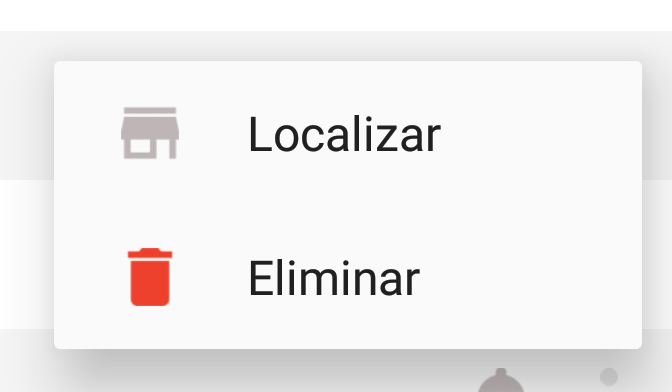
la classe MenuPopupHelper dans AppCompat a l'annotation @hide . Si C'est un problème, ou si vous ne pouvez pas utiliser AppCompat pour quelque raison que ce soit, il y a une autre solution utilisant un Spannable dans le titre MenuItem qui contient à la fois l'icône et le texte du titre.
les principales étapes sont:
- gonflez votre
PopupMenuavec unmenufichier xml - si l'un des articles a une icône, alors le faire pour tous des articles:
- si l'élément n'a pas d'icône, de créer une icône transparente. Cela garantit que les articles sans icônes seront alignés avec des articles avec des icônes
- créer un
SpannableStringBuildercontenant l'icône et le titre - placer le titre de l'article de menu à la
SpannableStringBuilder - placer l'icône de l'élément de menu à null," juste au cas où "
Pros: Pas de réflexion. Ne pas utiliser toute caché api. Peut fonctionner avec le cadre PopupMenu.
contre: plus de code. Si vous avez un sous-menu sans icône, Il aura le rembourrage gauche indésirable sur un petit écran.
détails:
d'abord, définissez une taille pour l'icône dans un fichier dimens.xml :
<dimen name="menu_item_icon_size">24dp</dimen>
Puis, quelques méthodes pour déplacer les icônes définies en xml dans les titres:
/**
* Moves icons from the PopupMenu's MenuItems' icon fields into the menu title as a Spannable with the icon and title text.
*/
public static void insertMenuItemIcons(Context context, PopupMenu popupMenu) {
Menu menu = popupMenu.getMenu();
if (hasIcon(menu)) {
for (int i = 0; i < menu.size(); i++) {
insertMenuItemIcon(context, menu.getItem(i));
}
}
}
/**
* @return true if the menu has at least one MenuItem with an icon.
*/
private static boolean hasIcon(Menu menu) {
for (int i = 0; i < menu.size(); i++) {
if (menu.getItem(i).getIcon() != null) return true;
}
return false;
}
/**
* Converts the given MenuItem's title into a Spannable containing both its icon and title.
*/
private static void insertMenuItemIcon(Context context, MenuItem menuItem) {
Drawable icon = menuItem.getIcon();
// If there's no icon, we insert a transparent one to keep the title aligned with the items
// which do have icons.
if (icon == null) icon = new ColorDrawable(Color.TRANSPARENT);
int iconSize = context.getResources().getDimensionPixelSize(R.dimen.menu_item_icon_size);
icon.setBounds(0, 0, iconSize, iconSize);
ImageSpan imageSpan = new ImageSpan(icon);
// Add a space placeholder for the icon, before the title.
SpannableStringBuilder ssb = new SpannableStringBuilder(" " + menuItem.getTitle());
// Replace the space placeholder with the icon.
ssb.setSpan(imageSpan, 1, 2, 0);
menuItem.setTitle(ssb);
// Set the icon to null just in case, on some weird devices, they've customized Android to display
// the icon in the menu... we don't want two icons to appear.
menuItem.setIcon(null);
}
enfin, créez votre PopupMenu et utilisez les méthodes ci-dessus avant de le montrer:
PopupMenu popupMenu = new PopupMenu(view.getContext(), view);
popupMenu.inflate(R.menu.popup_menu);
insertMenuItemIcons(textView.getContext(), popupMenu);
popupMenu.show();
j'ai résolu mon problème de la manière la plus simple possible jamais, jamais attendu une telle simplicité:
.xml:
<menu xmlns:android="http://schemas.android.com/apk/res/android" >
<item
android:id="@+id/action_more"
android:icon="@android:drawable/ic_menu_more"
android:orderInCategory="1"
android:showAsAction="always"
android:title="More">
<menu>
<item
android:id="@+id/action_one"
android:icon="@android:drawable/ic_popup_sync"
android:title="Sync"/>
<item
android:id="@+id/action_two"
android:icon="@android:drawable/ic_dialog_info"
android:title="About"/>
</menu>
</item>
dans activité principale.java
@Override
public boolean onCreateOptionsMenu(Menu menu) {
// Inflate the menu; this adds items to the action bar if it is present.
getMenuInflater().inflate(R.menu.main, menu);
return true;
}
C'était un truc en utilisant un sous-menu
si vous voulez afficher l'icône dans le menu contextuel, regardez https://github.com/shehabic/Droppy , c'est assez cool et facile à utiliser
vous pouvez mettre en œuvre cela par L'utilisation de la réflexion si vous ne le connaissez pas avec l'aide de cette impressionnante java fonctionnalité avancée u peut modifier le comportement d'exécution des applications en cours d'exécution dans le JVM, vous pouvez regarder l'objet et effectuer ses méthodes à l'exécution et dans notre cas, nous avons besoin de modifier le comportement popupMenu à l'exécution au lieu d'étendre la classe de base et de le modifier;) espoir que l'aide
private void showPopupMenu(View view) {
// inflate menu
PopupMenu popup = new PopupMenu(mcontext, view);
MenuInflater inflater = popup.getMenuInflater();
inflater.inflate(R.menu.main, popup.getMenu());
Object menuHelper;
Class[] argTypes;
try {
Field fMenuHelper = PopupMenu.class.getDeclaredField("mPopup");
fMenuHelper.setAccessible(true);
menuHelper = fMenuHelper.get(popup);
argTypes = new Class[]{boolean.class};
menuHelper.getClass().getDeclaredMethod("setForceShowIcon", argTypes).invoke(menuHelper, true);
} catch (Exception e) {
}
popup.show();
}
D'après la réponse de @Ajay...voici ce que j'ai fait
@Override
public boolean onCreateOptionsMenu(Menu menu) {
getMenuInflater().inflate(R.menu.add_task, menu); // for the two icons in action bar
return true;
}
@Override
public boolean onOptionsItemSelected(MenuItem item) {
switch (item.getItemId()) {
case R.id.menu:
View menuItemView = findViewById(R.id.menu);
MenuBuilder menuBuilder =new MenuBuilder(this);
MenuInflater inflater = new MenuInflater(this);
inflater.inflate(R.menu.popup, menuBuilder);
MenuPopupHelper optionsMenu = new MenuPopupHelper(this, menuBuilder, menuItemView);
optionsMenu.setForceShowIcon(true);
optionsMenu.show();
default:
return super.onOptionsItemSelected(item);
}
}
popup
<?xml version="1.0" encoding="utf-8"?>
<menu xmlns:android="http://schemas.android.com/apk/res/android">
<item
android:id="@+id/opt1"
android:icon="@drawable/change_pic"
android:title="Change Picture" />
<item
android:id="@+id/opt2"
android:icon="@drawable/change_pin"
android:title="Change Password" />
<item
android:id="@+id/opt3"
android:icon="@drawable/sign_out"
android:title="Sign Out" />
</menu>
Capture d'écran
j'essayais la réponse de @Stephen Kidson et @david.la suggestion de schereiber, et je me suis rendu compte qu'il n'y a pas une telle méthode setOnMenuItemClickListener dans MenuBuilder . J'ai un peu trafiqué le code source du v7 et j'ai trouvé cette solution:
MenuBuilder menuBuilder = new MenuBuilder(mContext);
new SupportMenuInflater(mContext).inflate(R.menu.my_menu, menuBuilder);
menuBuilder.setCallback(new MenuBuilder.Callback() {
@Override
public boolean onMenuItemSelected(MenuBuilder menu, MenuItem menuItem) {
// your "setOnMenuItemClickListener" code goes here
switch (menuItem.getItemId()) {
case R.id.menu_id1:
// do something 1
return true;
case R.id.menu_id2:
// do something 2
return true;
}
return false;
}
@Override
public void onMenuModeChange(MenuBuilder menu) {
}
});
MenuPopupHelper menuHelper = new MenuPopupHelper(mContext, menuBuilder, v);
menuHelper.setForceShowIcon(true); // show icons!!!!!!!!
menuHelper.show();
